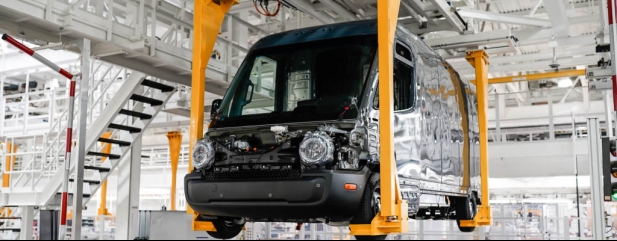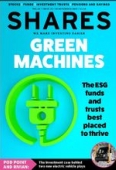Archived article
Please note that tax, investment, pension and ISA rules can change and the information and any views contained in this article may now be inaccurate.
Pod Point and Rivian: the investment case behind two new electric vehicle plays

As the COP26 climate summit fades into the middle distance it is clear that a key component of global leaders’ plans for reducing emissions is encouraging a big switch among businesses and individuals to EVs (electric vehicles). In the UK, sales of new diesel and petrol cars are already set to be banned from 2030.
The International Energy Agency forecasts the global stock of EVs will increase from 11 million in 2020 to 145 million in 2030 and will account for 7% of the world’s fleet of road vehicles (excluding two or three-wheelers). Sales of new EVs are projected to hit 15 million by 2025 and 25 million by 2030 – 10% and 15% of all road vehicle sales worldwide.
This kind of growth will require a big effort on the part of EV manufacturers and the businesses behind the charging infrastructure required to power these electric cars, trucks and vans.
RIVIAN AND POD POINT JOIN THE MARKET
Earlier this month two new business listed on the stock market on opposite sides of the Atlantic and at either ends of the EV eco-system. Electric van and truck maker Rivian Automotive floated on Nasdaq to widespread applause with the shares initially priced above the top of the guide range at $78 before closing over $100 on its first day.
The business was briefly valued at more than $100 billion, comfortably eclipsing the valuation of established carmakers like General Motors and Ford.
Pod Point (PODP), the EV charging play, made a much quieter debut in London with its market valuation coming in lower than expected.
Something both businesses have in common is they are yet to make a profit. In this article we’ll discuss to what extent that matters and the challenges and opportunities facing both businesses.
UNDER RIVIAN’S BONNET
Rivian was set up by engineer RJ Scaringe in 2009. It came to market with heavyweight backing in the form of Ford, which has an 11.3% holding, and online giant Amazon which has a 17.6% stake and has also put in an order for 100,000 EDVs (electric delivery vehicles).
From the start of 2019 to the end of June 2021, Rivian had chalked up losses in excess of $2.4 billion.
Starting with a blank sheet of paper as a manufacturer has its advantages, as unlike its peer group Rivian doesn’t have the legacy of internal combustion engined-vehicles to deal with.
On the other hand, scaling up manufacturing capacity involves huge capital costs. The near $12 billion raised at IPO will certainly help, but it could be some time before Rivian reaches break- even point.
As at 30 September, Rivian had the Amazon order for 100,000 EDVs, which it hopes to fulfil by 2025, and nearly 50,000 pre-orders for its R1T pick-up truck and R1S SUV from customers in the US and Canada who each paid a cancellable and fully refundable deposit of $1,000.
With prices starting at $67,500, reviews for the R1T in trade press have been highly favourable. However, the company clearly needs to convert these 50,000 pre-orders into sales which may require patience on the part of potential customers given its current modest annual production capacity of just 150,000 units. As of 22 October, the firm had only built and delivered 42 R1Ts, mostly for existing employees.
The danger is that in the meantime rivals with existing capacity will swoop in and take prospective market share from Rivian.

DAN LOEB BULLISH ON RIVIAN
UK-listed investment trust Third Point Offshore Investors (TPOU) also has a stake in Rivian, and manager and noted activist investor Dan Loeb made some very positive comments on the stock in his latest commentary.
‘Rivian stands out with a compelling brand, an excellent first vehicle, and a unique partnership with Amazon that allows them to scale quickly,’ he said.
‘They are taking full advantage of the direct-to-consumer model/digital ecosystem to attack the full lifetime revenue potential from vehicles rather than simply an upfront sale.’
Should you buy Rivian and Pod Point shares?
Both firms are difficult to value as they operate in relatively immature markets and don’t generate any profit, nor will they in the short term. Rivian’s valuation is certainly punchy for a business which has only built a miniscule number of vehicles to date.
Judging by the trajectory of Tesla though, this would be no obstacle to Rivian enjoying continued share price momentum. However, it is worth monitoring the business closely for signs it can successfully scale up production and generate sufficient demand at its current price points.
Investors looking for lower-risk exposure to Rivian should by shares in Ford. As well as already generating plenty of profit and cash flow from its existing business, Ford also has a sizeable stake in Rivian and its own EV expansion plan is in the works.
We have reservations about Pod Point, which also trades at reasonably generous valuation (although not as lofty as Rivian) despite limited visibility on its road to profitability and a highly competitive marketplace.
We would suggest holding fire and keeping a watching brief on the stock for now. The firm’s majority owner, French utility group EDF, may seek to sell down its sizeable stake in the future, potentially creating a more attractive entry point when the firm has established more of a track record as a public company and made more progress on its growth strategy.
Loeb’s observations highlight Rivian’s longer-term plan, which is to leverage its position by offering subscription-based services which can generate recurring revenue streams from its installed base of vehicles and also to move into areas like charging infrastructure.
POD POINT A HOME CHARGING LEADER
Pod Point is the UK market leader in at-home charging points with a 50% to 60% share and the second biggest player in workplace charge points with a share of between 10% and 20%.
The manager of MFM UK Primary Opportunities Fund (B905T77) Oliver Brown tends to run the rule over most initial public offerings given his fund’s strategy of investing in companies when there is an opportunity to purchase shares through IPOs or secondary placings.
He admits he looked at Pod Point but opted to steer clear. ‘I just couldn’t get comfortable with the valuation,’ he says, noting that analysts’ forecasts suggest the company won’t be cash positive until 2025. And even this inflection points relies on what Brown describes as ‘slightly heroic’ growth assumptions.
Brown also compares EDF’s purchase price for a controlling stake in the business of £110 million in February 2020 with the current market valuation upwards of £350 million.
‘I find it slightly difficult to accept the business has trebled in value in the last 18 months,’ he says.

DIFFERENT CHARGING OPTIONS
While in theory electric vehicles can be charged directly from a home’s mains electricity, charging points like those Pod Point installs do the job significantly quicker. Prices for its individual home units range from around £800 to £1,600, although government-backed subsidies are available.
There are two main types of charging point: AC and DC (not to be confused with a certain Australian rock outfit). Without getting too technical, the main distinction between these two pieces of kit is cost and, crucially, charging time.
Brown notes the installation cost of the faster charging DC units, likely to be in greater demand at public locations such as retail parks and motorway service stations, is approximately £130,000.
Pod Point makes its own AC units but sources DC charge points from third parties. In both cases the majority of these devices are Wi-Fi enabled.
It has agreements in place with both Lidl and Tesco, and since 2016 has been Volkswagen’s recommended home and workplace supplier in the UK.
In 2020, just 1.7% of Pod Point’s revenue was recurring in nature, derived from network fee payments from commercial customers and revenue-share each time a Pod Point charging point is used.
Brown says average utilisation rates on these charge points are only around 4% at present and are forecast to hit 35% by 2028, but as he points out there are clear risks to Pod Point’s growth forecasts if utilisation rates do not follow this expected trajectory.

RECURRING REVENUE FOCUS
Pod Point’s success or failure may well hinge on its ability to generate material recurring revenues from the home charging market. It believes there are several ways to achieve this, leveraging the fact its Wi-Fi enabled charge points are connected to its back-end systems and therefore it is able to collect information on charging habits.
Areas Pod Point is targeting include energy monitoring services (for example, offering a tariff-switching service based on drivers’ levels of energy consumption), host software services (allowing Pod Point’s charge point hosts to set and manage charging tariffs for drivers) and electrical grid load management (supporting grid operators and generators in managing demand).
Brown notes revenue is forecast to grow rapidly, from £33.1 million in 2020 to £90 million in 2023, and says that he wouldn’t rule out investing in the business one day, potentially when or if EDF looks to sell down some of its 50%-plus stake.
Another consideration is the competitive landscape where Pod Point has established a very healthy but not unassailable market position.
Both BP (BP.) and Royal Dutch Shell (RDSB) have their own EV charging operations, a large footprint and decades of experience in serving motorists as well as much greater financial resources and incentives to invest in this space as they look to transition away from fossil fuels.
On the flipside this could make Pod Point an attractive takeover target for these larger firms at some stage.

Important information:
These articles are provided by Shares magazine which is published by AJ Bell Media, a part of AJ Bell. Shares is not written by AJ Bell.
Shares is provided for your general information and use and is not a personal recommendation to invest. It is not intended to be relied upon by you in making or not making any investment decisions. The investments referred to in these articles will not be suitable for all investors. If in doubt please seek appropriate independent financial advice.
Investors acting on the information in these articles do so at their own risk and AJ Bell Media and its staff do not accept liability for losses suffered by investors as a result of their investment decisions.

 magazine
magazine








